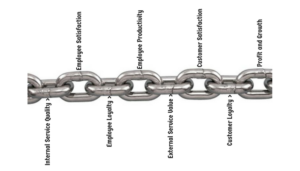
If there is one strategy tool for building profitability in a service organization, it is the service-profit chain.
This ‘chain’ works based on the natural concept of chains which is that a chain is only as strong as its links. Hence, to make a chain strong, all the links must be made strong. Conversely, if any link of a chain is weak, the whole chain is as weak as that link.
Developed by a group of researchers from Harvard University, the service profit chain dissects the levers that translate good service into profitability. These levers are represented by links in an eight-link chain as depicted below.

The Service-Profit Chain
The service-profit chain works this way: Employee satisfaction increases when the internal service quality is enhanced. When the employee is satisfied, loyalty increases which raises productivity. Higher productivity results to delivery of greater external service value to customers and this enhances customer satisfaction and loyalty. Profit and growth are then stimulated by customer loyalty.
Thus, to influence profit and growth in your organization, what you would need to do is look at the root which is the internal service quality.
The internal service quality is the quality of support services employees receive from fellow employees within the organization. It’s also how employees are equipped with the skills and power to serve customers. The internal service quality often gets little attention. However, it’s of key importance.
As evident in the service-profit chain, it’s from the internal service quality that the journey to profitability begins. And just as in a typical chain, the first link leads into the second, and the second into the third, and it continues to the eighth link which is profit.
So to maximize your organization’s profits, you need to strengthen all the links in your service-profit chain – not some. This is because every link of the chain is important. If employees are satisfied but not productive, then it will not lead to value, which will not lead to customer satisfaction and so on.
In other words, an organization that performs well in one aspect (strong link) and poorly in another (weak link) will eventually develop problems that affect the entire organization.
That’s why leaders who understand and use the service-profit chain develop and maintain a corporate culture that pays adequate attention to all eight links. They know, for instance, that focusing only on service to customers is a flawed strategy because it does not take care of the internal service quality hence leaving that link weak. And since a chain is as strong as its weakest link, profit and growth will not improve.
Some years back, a US fast food giant Taco Bell found that its outlets with low workforce turnover (a key marker of employee loyalty) enjoyed double the sales and 55% higher profits than outlets with high turnover. To boost profitability across outlets, it only enhanced internal service quality – by giving employees more latitude for on-the-job decision making.
This is a typical example of the use of the service-profit chain. To increase profit across outlets in Taco Bell, the leaders did not increase target on sales, neither did they reduce workforce to minimize costs, rather they tackled the problem from the root after assessing their service-profit chain and realizing that they simply needed to strengthen one of the links – the internal service quality.
How about your organization? Are your expectations on profitability being met? If not, it’s recommended that you use the service-profit chain to make a holistic and effective assessment so as to identify the weak link(s) and begin to strengthen accordingly.
The outcome of using the service-profit chain is an increased and careful attention to the needs of both customers and employees. For optimal results, organizations should have a good customer feedback loop, a good employee feedback loop, and a good process for making sure input, feedback and ideas get implemented.